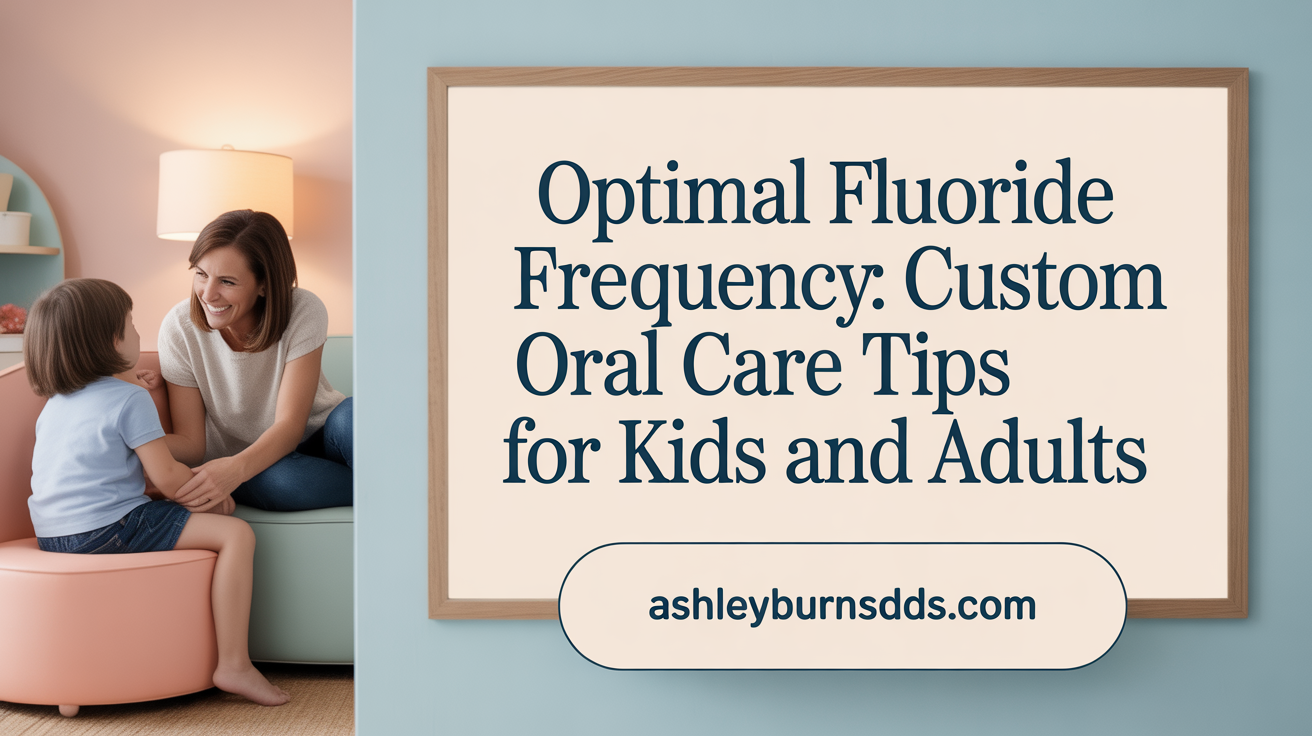Why Fluoride Matters for Your Oral Health
Fluoride treatments have become a cornerstone of preventive dental care, benefiting both children and adults by strengthening teeth and reducing the risk of cavities. This natural mineral plays a critical role in maintaining oral health through various delivery methods and scientifically backed mechanisms, ensuring healthier smiles across the lifespan. In this article, we explore the multifaceted benefits of fluoride, how it works to protect enamel, the range of application techniques, safety considerations, and guidelines tailored to different age groups.
How Fluoride Protects and Strengthens Teeth for All Ages

What are the benefits of fluoride treatments for both adults and children?
Fluoride treatments provide notable advantages for people of all ages, aiding in the prevention of dental cavities by reinforcing enamel and promoting remineralization. For children, fluoride helps develop stronger, healthier teeth during critical growth phases, reducing the risk of early decay and supporting proper alignment. In adults, fluoride continues to fortify enamel that naturally wears down with age, helping to prevent cavities, reduce tooth sensitivity, and protect dental restorations like crowns or fillings.
Regular fluoride applications—whether through community water, toothpaste, gels, varnishes, or supplements—significantly decrease the prevalence of cavities across populations. Studies show that fluoride can prevent about one-third of cavities in primary teeth and up to 40-60% in permanent teeth.
In addition to cavity prevention, fluoride treatment is a safe, cost-effective strategy that reduces painful dental procedures, overall treatment costs, and improves long-term oral health. Its ease of application and proven effectiveness make fluoride a cornerstone in preventive dental care for children and adults alike.
Various Fluoride Delivery Methods and Their Effectiveness

What are the different methods of fluoride delivery?
Fluoride supports oral health through multiple delivery methods. Community water fluoridation involves adding controlled amounts of fluoride to public water supplies, effectively reducing cavity rates across entire populations. Topical fluoride applications administered by dental professionals include varnish, gels, foams, and rinses, which are directly painted or brushed onto teeth to enhance enamel strength. At home, individuals use fluoride toothpaste and mouth rinses containing fluoride to reinforce their teeth daily. For children and those at higher risk of decay, fluoride supplements such as chewable tablets or lozenges are prescribed to ensure adequate fluoride intake, particularly in areas where water isn’t fluoridated. Collectively, these methods strengthen enamel, repair early decay, and serve as a crucial barrier against cavity formation.
How effective are fluoride treatments across age groups?
Fluoride treatments prove beneficial at every stage of life. In children, especially during tooth development, fluoride promotes strong enamel formation and helps prevent early cavities. However, excessive fluoride exposure during this critical period may cause dental fluorosis, which appears as faint white streaks or spots but can sometimes lead to enamel pitting.
For adults, fluoride continues to play an essential role in maintaining dental health. It helps rebuild enamel that naturally wears down with age, reduces tooth sensitivity, and can protect exposed roots due to gum recession. Adults with a history of cavities, dry mouth, or dental restorations benefit significantly from fluoride treatments, which bolster teeth's resistance to decay.
Proper supervised use and regulation of fluoride sources, tailored to individual needs, maximize benefits while minimizing risks like fluorosis. Overall, fluoride treatments are a fundamental component of preventive dentistry regardless of age.
What is the scientific basis and evidence supporting the use of fluoride in dentistry?
Extensive scientific research underpins fluoride’s role in cavity prevention. Fluoride enhances remineralization by attracting calcium and phosphate ions to damaged enamel, forming fluorapatite, a more decay-resistant mineral. Studies consistently demonstrate that fluoride reduces the incidence of cavities by about 25% to 60%, depending on the mode of delivery and population.
Epidemiological data from over 60 years of community water fluoridation show a significant decline in dental caries, with reductions of approximately 40-60%. Systematic reviews affirm that fluoride, in various forms, is safe and effective when used appropriately. The optimal fluoride level in water—currently recommended at 0.7 parts per million—balances maximum benefit with minimal risk of fluorosis, a condition resulting from excess fluoride during tooth formation.
In conclusion, scientific evidence affirms fluoride as a vital, cost-effective tool in public health dentistry, protecting teeth and reducing the need for costly restorative treatments worldwide.
| Method | Applicability | Effectiveness | Additional Notes |
|---|---|---|---|
| Community Water Fluoridation | Entire population | 40-60% reduction in cavities | Most widespread, cost-effective |
| Topical Application (Varnish, Gel, Rinse) | Children & adults | Reduces early decay, strengthens enamel | Professional application recommended |
| Fluoride Toothpaste | All ages | Significantly reduces cavities | Daily use encouraged |
| Fluoride Supplements | Children at high risk | Prevents early childhood decay | Prescribed for low-fluoride areas |
| Fluoride in Food & Drinks | General exposure | Contributes to overall protection | Natural levels vary |
Proper implementation ensures maximum benefits and safe use of fluoride for lifelong oral health.
Safety of Fluoride Use and Managing Risks Like Fluorosis

What are the safety considerations and potential risks associated with fluoride use, such as fluorosis?
Fluoride use is generally safe when following recommended guidelines; however, overexposure can lead to health issues like dental fluorosis. Fluorosis occurs when children used excess fluoride during enamel formation, resulting in white streaks, mottling, or pitting of the enamel. The risk is highest when fluoride levels in water exceed 1.5 ppm, whereas properly fluoridated water is maintained around 1 ppm to optimize benefits and reduce risks. To prevent fluorosis, it is important to monitor fluoride intake in young children, control fluoride levels in water sources, and educate caregivers about appropriate fluoride use, especially in toothpaste and supplements. Although fluoride effectively prevents cavities, inappropriate use can increase the risk of fluorosis, so adherence to guidelines ensures safety and benefits.
What are the guidelines for fluoride intake for different age groups?
Fluoride intake must be tailored to different ages to enhance dental protection and avoid overexposure. Infants (up to 6 months) should get about 0.01 mg daily, mainly from formula or breast milk. Toddlers (1-3 years) are advised to consume approximately 0.7 mg daily. Children aged 4 to 8 years need around 1.0 to 2.0 mg daily, depending on their sources such as fluoridated water and toothpaste. Adolescents and adults require higher amounts, with adult women advised to have around 3 mg and men about 4 mg daily, to support ongoing cavity prevention. During early childhood, especially from birth to age 8, controlling fluoride exposure is critical to prevent fluorosis. Measures include supervising children's toothpaste use, avoiding excessive supplements, and ensuring fluoride levels in drinking water remain within safe limits. Proper management helps maximize fluoride benefits while minimizing the risk of enamel changes associated with fluorosis.
Recommended Fluoride Treatment Frequency for Adults and Children

What is the recommended frequency of fluoride treatments for adults?
For most adults, fluoride treatments are recommended once every 6 to 12 months as part of routine dental check-ups, especially for those at average risk of cavities. However, adults with higher risk factors—such as gum recession exposing roots, dry mouth, frequent cavities, or high sugar intake—may need treatments more often, every 3 to 6 months. Professional fluoride applications like varnishes and gels are quick, painless, and provide several months of added protection.
It is important for adults to discuss their specific dental health conditions with their dentist. Personalized treatment schedules help maximize the benefits of fluoride, reinforce enamel, and prevent future decay. Incorporating fluoride into regular dental visits is a cost-effective way to maintain strong, healthy teeth over time.
Guidelines for fluoride use in children
Children’s fluoride needs vary by age and risk level. For children under three years old, a tiny smear of fluoride toothpaste (containing about 1000 ppm fluoride) is recommended. From ages three to six, a pea-sized amount of fluoride toothpaste, used under supervision to prevent swallowing, is suitable.
Professional fluoride treatments, such as varnishes and gels, generally start around age six when primary teeth have erupted fully. These treatments are typically scheduled every three to six months for children at higher risk of cavities. Children at average risk might need less frequent applications.
Early in childhood, fluoride intake from water, foods, and dental products helps in developing strong enamel and preventing early decay. Regular dental visits allow for assessment and adjustment of fluoride application frequency, ensuring children receive appropriate preventive care.
Professional fluoride treatment schedules
Routine professional fluoride application is advisable at least twice a year for children and at-risk teenagers, with some guidelines recommending three to four times annually for those with higher decay risk.
For adults, dental professionals often suggest fluoride varnishes or gels about once every 6 months to 12 months, especially for individuals with gum recession, exposed roots, or restorations prone to decay.
In cases of increased risk, such as dry mouth or frequent cavities, more frequent treatments are beneficial. Dentists tailor these schedules based on individual conditions to help prevent cavities, repair early decay, and strengthen enamel.
| Age Group | Recommended Treatment Frequency | Typical Fluoride Use & Notes |
|---|---|---|
| Children under 3 | As needed (supervised brushing with minimal fluoride toothpaste) | Tiny smear of fluoride toothpaste, early prevention focus |
| Children 3–6 | Every 3 to 6 months (professional or supervised home use) | Pea-sized toothpaste, fluoride varnish or gel application |
| Children 6–12 | Every 3 to 6 months | Routine varnish applications, reinforcement of prevention |
| Adolescents and young adults | Every 6 to 12 months | Ongoing cavity prevention, especially for those with orthodontics |
| Adults | Every 6 to 12 months | Tailored to individual risk—more frequent if needed |
| At-risk adults | Every 3 to 6 months | For gum recession, exposed roots, dry mouth, or existing restorations |
Ultimately, following personalized advice from dental professionals remains the best approach for effective fluoride use across all ages.
Integrating Fluoride Treatments into Holistic Oral Care Practices

Importance and advantages of fluoride treatments for all ages
Fluoride is essential for maintaining strong, healthy teeth at every stage of life. For children, fluoride helps develop robust enamel during tooth formation, preventing early decay and supporting proper dental alignment. It can reduce cavity risk by approximately 40-60%, especially in primary teeth. In adults, fluoride continues to play a vital role by reinforcing enamel that wears down over time, reducing sensitivity, and protecting restorations like crowns or fillings. Regular fluoride treatments can also help prevent root decay in older adults with receding gums.
Complementary oral health practices enhancing fluoride benefits
To maximize fluoride’s protective effects, it should be part of a comprehensive oral health routine. Good practices include using fluoride toothpaste, limiting sugary foods, and maintaining regular dental visits. For high-risk individuals, professionally applied fluoride varnishes, gels, or foams are highly effective. Additionally, avoiding excessive fluoride intake reduces the risk of fluorosis, which can cause white streaks or pitting in teeth. Combining these habits ensures healthier teeth, better resistance to bacteria-produced acids, and long-term oral wellness.
Cost-effectiveness and public health impact of fluoride
Community water fluoridation is recognized as a highly cost-effective public health measure that reduces dental decay by about 25%. Over 75% of U.S. water supplies are fluoridated, credited with significantly lowering cavity rates and improving dental health across populations. The cost of professional fluoride treatments—typically around $30–$35—is much less than restorative procedures like fillings. Broad access to safe, fluoride-based preventive care decreases dental treatment costs and contributes to healthier communities.
| Aspect | Benefits | Details |
|---|---|---|
| Prevention | Reduces cavities by up to 60% | Especially effective in children and high-risk groups |
| Cost Savings | Low-cost prevention | Cheaper than treatment of active decay |
| Public Health | Enhanced community dental health | Supported by over 100 health organizations |
Fluoride Treatments: A Safe, Effective Tool for Lifelong Dental Health
Fluoride remains a vital ally in the fight against tooth decay for both children and adults. Its well-documented ability to strengthen enamel, promote remineralization, and reduce harmful bacterial activity underscores its value as a preventive measure. Delivered through a variety of accessible means—from community water fluoridation to professional varnishes and home care products—fluoride treatments adapt to the needs of all ages and risk levels. While safety considerations such as the risk of fluorosis require prudent management, adherence to recommended guidelines ensures fluoride’s benefits far outweigh potential drawbacks. Incorporating fluoride treatments into routine dental care and public health strategies is a powerful way to maintain oral health, reduce dental costs, and secure healthier smiles for life.
References
- The Fluoride Debate: The Pros and Cons of Fluoridation - PMC
- Importance of Regular Fluoride Treatment for Kids, Teens, and Adults
- The Benefits of Fluoride Treatment | Grove City Smiles
- Benefits of Fluoride for Adults and Children of All Ages
- Fluoride for the whole family: Protecting smiles at every age
- Fluoride: Topical and Systemic Supplements
- Benefits of Fluoride Treatments For Adults: Is It Right For You?
